Are you curious what the water snake you saw in the lake or river was? There are more than 45 snake species in Georgia, of which there are 16 that live in water.
Continue reading to find out all the snakes that live in the water in Georgia.
Are Water Snakes In Georgia Venomous?
The majority of the water snakes you encounter in Georgia are not harmful to humans, except for two: the Northern Cottonmouth and the Florida Cottonmouth.
The Northern Cottonmouths venom causes the tissue to be destroyed in the bite site, often leaving a scar. There are occasions where amputation has been needed, but the venom is not deadly to humans.
The Florida Cottonmouth that is an aggressive and venomous water snake with a toxic venom that can be fatal to humans.
The good news is that bites are very rare.
Types Of Water Snakes In Georgia
There are 16 water snakes you may see in Georgia lakes, rivers, and swamps, these include:
1. Northern Watersnake

Scientific name: Nerodia sipedon.
Common name: Northern watersnake.
Venomous: No
The Northern watersnake is a large non-venomous snake, native to North America. It is often confused with the cottonmouth.
They can grow up to 135 cm (4 ft 5 in) in length, which includes the tail.
They range in color from brown/black to red, gray, and brown with dark crossbands on the neck and patches on the body. The color darkens as they age with the pattern fading, which results in some of these water snakes being completely black.
Their belly can range from gray to white or yellow with red or black crescents.
They are active during the day and night, often seen basking on rocks.
They hunt in the plants along the water’s edge, where they feed on frogs, worms, leaches, small fish, small birds and crayfish.
You often spot these water snakes on the edge of streams where they bask in the sun. They soon dive into the water when they hear you coming. They are fast and will flee from danger. They can inflict a painful bite if cornered or captured.
They live near ponds, marshes, canals, rivers, and lakes where they hide among plant stems, usually close to beaver lodges and muskrat houses.
2. Common Garter Snake

Scientific name: Thamnophis sirtalis.
Common name: Common garter snake.
Venomous: No
The common garter snake grows to 66cm (26 inches) in length, but there are records of them growing to 124cm (49 inches).
They have three yellow stripes down a dark body, though some appeared checkered in appearance with light stripes on a red or gray body.
The common garter snakes you find in Georgia may also have a blue tinge to their base color.
Their bellies are a light yellow to white.
The male’s tail is thicker and longer than the female’s.
They are very common in marshes, meadows, hillsides, and woodlands, where they look for moist and grassy environments close to water. So, you are likely to see one on the edge of a lake, stream, or pond.
These snakes feed on slugs, frogs, toads, fish, and tadpoles and are active throughout the year, where they are active during the day and night.
This species is protected in the state of Georgia.
3. Banded Watersnake

Scientific name: Nerodia fasciata.
Common name: banded water snake, southern water snake.
Venomous: No
The banded water snake grows to 106.7cm (48 inches) long and is a heavy-bodied snake that is semi-aquatic.
Their colors vary from red or light brown to black with dark cross bands. The crossbands are larger at the middle of the back and narrow at the sides, they fade as the snake ages.
They also have square patches on the side of their tummy with a dark stripe that runs from the eye to the jaw.
They can be found in just about any freshwater habitat from ponds, and lakes to rivers, streams, swamps, marshes, and wetlands.
They are active during the day and night and are often observed basking in the sun on a branch or log that hangs over the water. They are also spotted hunting in the shallow water.
This species is protected in the state of Georgia.
4. Plain-bellied Watersnake

Scientific name: Nerodia erythrogaster.
Common name: plain-bellied water snake, plainbelly water snake.
Venomous: No
The plain-bellied water snake is a thick-bodied and large snake that is solid in color with a variety of colors ranging from black to olive green and green/gray to gray or brown. Their bellies range from yellow to red.
Adults grow to around 122cm (40 inches), including their tails. Juveniles have a band pattern with unmarked bellies, which makes them easily identifiable.
They are seen near permanent water sources such as floodplains, rivers, ponds and lakes, along with natural wetlands.
5. Diamondback Water Snake

Scientific name: Nerodia rhombifer.
Common name: diamondback water snake.
Venomous: No
The diamondback water snake is a non-venomous water snake that is endemic to the United States.
They are usually dark olive green, brown or dark brown in color with black patterns on their back that resembles a net. Each spot has a diamond shape. They have lighter coloring down their sites with a yellow to light brown belly with black patches.
They can grow up to 122cm (48 inches) with total recorded lengths reaching 180cm (69 inches).
They are seen near slow-moving waters, such as rivers ponds, swamps, and streams. They hang suspended on branches above the water when hunting for food, their head dipping under the water surface until it finds its prey.
If you get too close it will slide into the water and swim away. Don’t be fooled, if you corner it, it will bite to defend itself. The bite is painful as they have sharp teeth.
6. Northern Cottonmouth

Scientific name: Agkistrodon piscivorus.
Common name: Northern cottonmouth, water moccasin, swamp moccasin, black moccasin, viper.
Venomous: YES
The northern cottonmouth is a pit viper and the only semi-aquatic viper. They are large and can give a potentially fatal bite.
They coil their body and display their fangs when threatened, which is a sign you must move away. They will only bite when they are cornered, handled, or feel threatened.

You can find the northern cottonmouth along slow-moving water, such as shallow lakes, marshes, and streams. They are good swimmers and are known to swim into estuaries and bays.
They are reported in the southern of Georgia.
They have a toxic venom, which is known to destroy tissue. Deaths are rare, but bites tend to leave scars and in some rare cases, have required amputation.
Bites can be treated effectively with an anti-venom.
7. Brown Watersnake
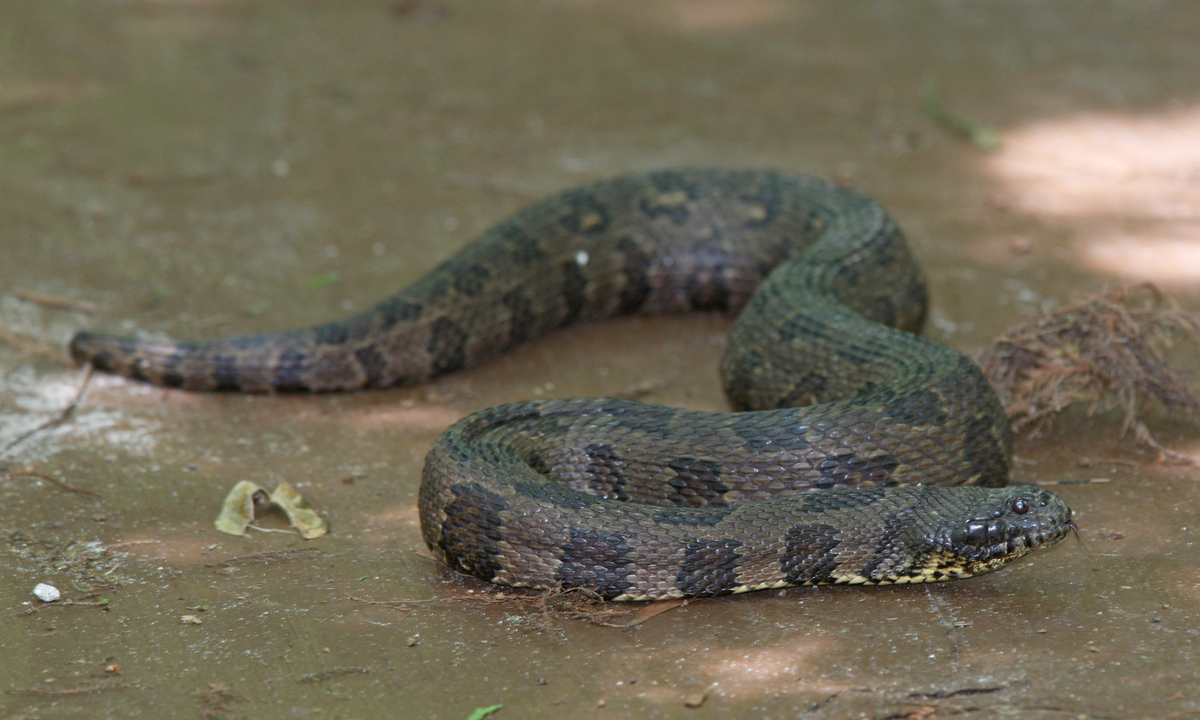
Scientific name: Nerodia sipedon.
Common name: brown water snake.
Venomous: No
The brown water snake is a large 152cm (60 inch) semi-aquatic snake that is heavy bodied.
The body color ranges from dark to light brown with dark brown square patches, with one line of patches running down the doors and two on either side of the body.
Their belly is light with brown patches and black crescents.
Their heads are wider than their necks, which gives their head a triangular appearance.
They are found in northern Georgia where they live in a range of aquatic habitats with flowing water such as cypress creeks, canals, and rivers. They prefer permanent water bodies as fish is their most common prey.
These snakes are excellent swimmers and feed mostly on small catfish.
They are also excellent cumbers and can be seen basking in the sun on logs and branches. They drop from their perch into the water if they get a fright and swim away.
Even though they are not venomous, they do give a painful bite.
8. Queen snake (Regina septemvittata)

Scientific name: Regina septemvittata.
Common name: queen snake.
Venomous: No
The queensnake is a medium-sized snake growing to around 61cm (24 inches).
They are slender and are found in flowing waters.
Adults and juveniles are gray in color, but their colors can range from olive green to light brown.
They have three dark stripes that run down the length of their bodies and two white to yellow stripes that run down their sides.
The belly is yellow and has four brown stripes, which is one on either side and two that run down the center of the belly.
These snakes are common where there is running water, such as rivers and streams. But they have been observed in lakes and other aquatic habitats.
They can usually be found in rocky habitats in the water where there is plenty of crayfish.
They tend to bask on rocks and vegetation, they are also mostly active during the day and can be seen crossing roads close to running water sources.
9. Eastern Ribbon Snake
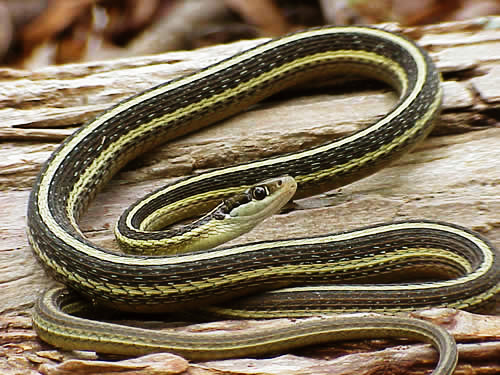
Scientific name: Thamnophis sauritus sauritus.
Common name: eastern ribbon snake, common ribbon snake.
Venomous: No
The eastern ribbon snake grows to around 71cm (28 inches) in length and they can be distinguished for the three yellow stripes that they have down their body, which are against a dark black ground.
These are semi-aquatic snakes and are often seen in salt marshes, lakes, and bogs.
They prey mostly on amphibians and small fish that swim near the shoreline.
10. Florida Cottonmouth

Scientific name: Agkistrodon piscivorus conanti.
Common name: Florida cottonmouth, green-tailed moccasin.
Venomous: YES
The Florida cottonmouth is one of the venomous water snakes you may observe in Georgia.
They grow to 74.5 inches (189cm) and can weigh up to ten pounds.
They have very visible head markings, even in older adults. They have visible stripes in front of their lower jaw and vertical stripes at the tip of the nose.
These snakes are often seen on the edge of cypress ponds, wooded edges of water, and swamps.
This is a venomous water snake that is highly aggressive and is often seen in swamp areas of canals, rivers, and lakes.
11. Mud Snake
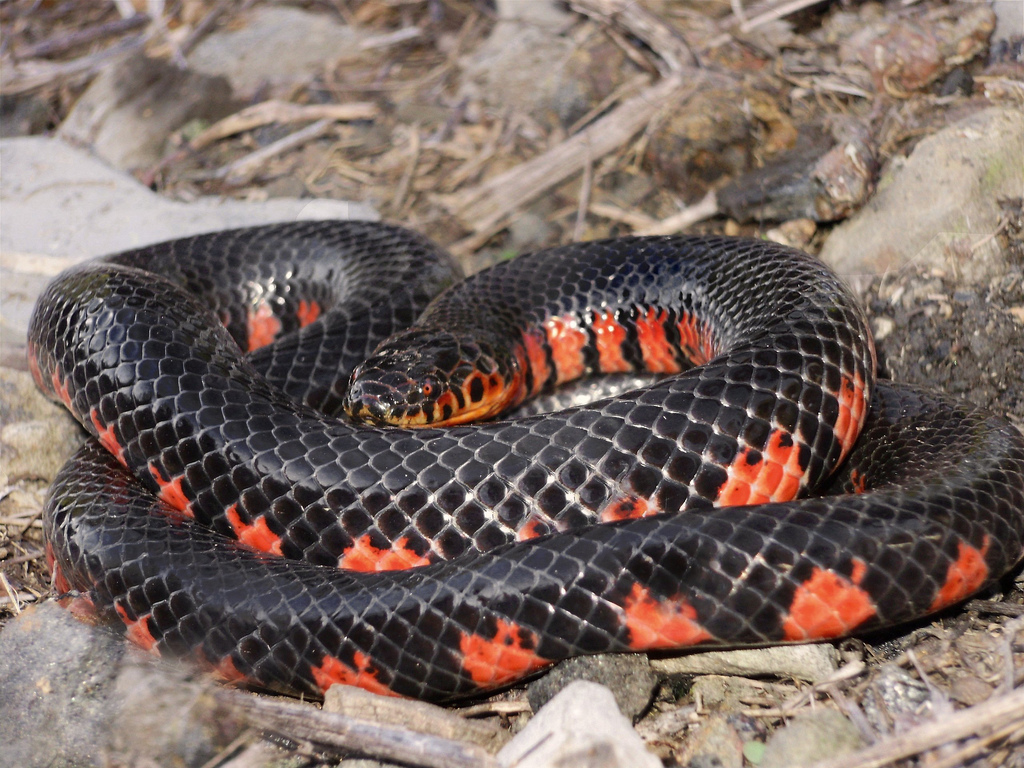
Scientific name: Farancia abacura.
Common name: Mud snake.
Venomous: No
The mud snake is a large non-venomous aquatic snake that grows up to 207cm (81 inches) in length.
It is very rare to see one of these snakes because they are so secretive.
They are heavy-bodied and black in color with red or pink check board patterns on their bellies, that moves up the sides.
The mud snake is common in western Georgia. They can be found in a variety of aquatic habitats from ditches and bays to swamps, wetlands, marshes, slow-moving streams, lakes, and ponds.
Even though they are predominantly aquatic, they can move far distances over land between water sources.
They spend most of their time hidden among vegetation and debris under the water and seldom come out to bask in the sun, which is why it is very rare to see one.
They will not bite if captured but will try and push their pointed tail against you, which has no effect.
They are sometimes referred to as hoop snakes, due to a myth that they bite their tail and roll after you.
12. Glossy Swampsnake

Scientific name: Liodytes rigida.
Common name: crayfish snake, glossy crayfish snake, glossy swampsnake, glossy water snake, striped water snake.
Venomous: No
The glossy swampsnake is a crayfish snake, it is highly aquatic and medium in size. They grow to around 61cm or 24 inches. They are heavy bodies with small heads and large eyes.
They tend to range from olive green to brown with two light stripes that run down the length of the body. They have a yellow underside with dark spots that are set out in two rows.
They live in a variety of aquatic environments from roadside ditches to cypress swamps to vegetated ponds and lakes.
The glossy swamp snake is not seen regularly, because they spend most of their time hidden under the water, though they can be spotted crossing a road on the very rare occasion making their way to the water.
They will hiss if they are captured or cornered but seldom bite.
13. Rainbow Snake
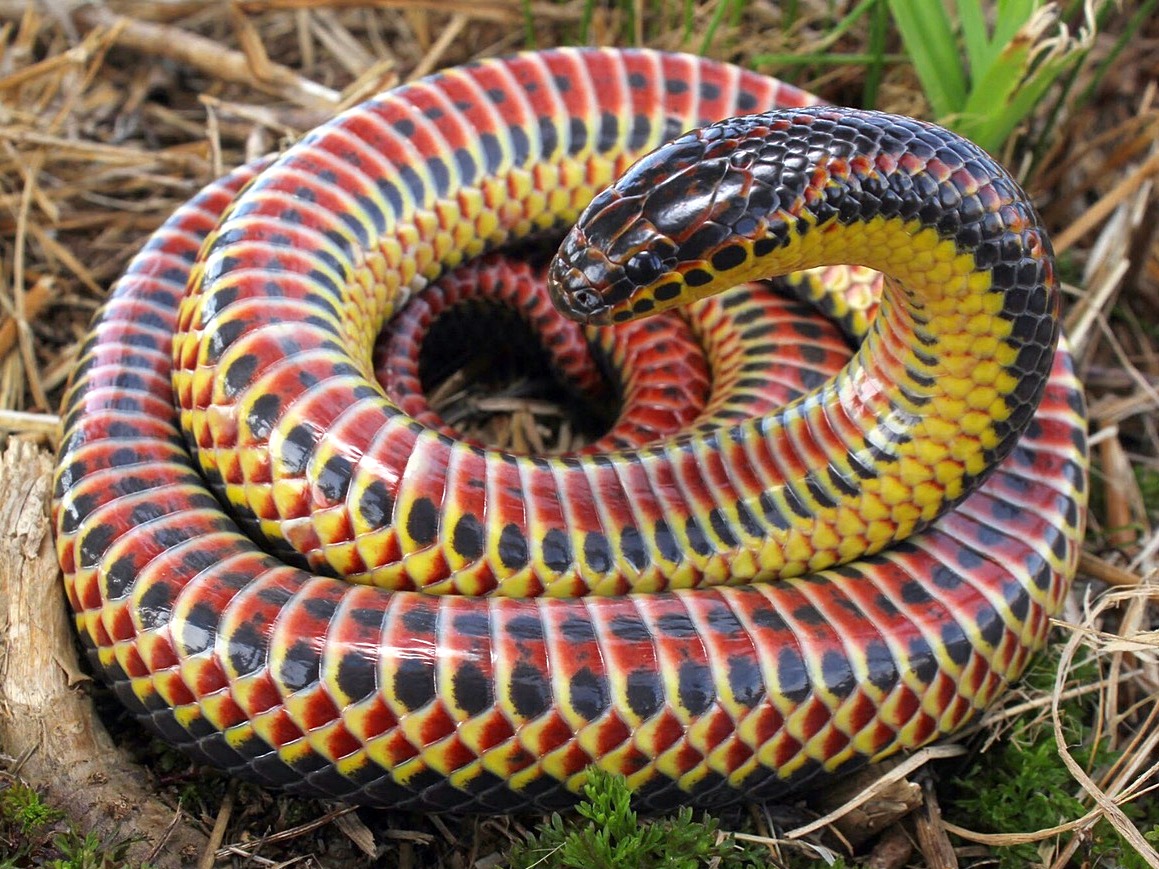
Scientific name: Farancia erytrogramma.
Common name: rainbow snake, eel moccasin.
Venomous: No
The rainbow snake is a large 168cm (66 in) non-venomous aquatic snake that is seldom seen.
It spends the majority of its life underwater, yet it is one of the most beautiful snakes you will ever see in the United States.
Adults have a black body with three red stripes that run down the length with pink or red undersides with a few rows of black spots. Their heads and sides usually have yellow coloration.
They live in a host of aquatic habitats but tend to be most common in flowing water such as black water creeks, rivers, and streams, along with cypress swamps. They are sometimes found in brackish or tidal water.
They can move overland though they prefer their aquatic habitat.
They do not bask out in the sun and therefore it is very rare to see one. If you do find one and capture it, it will not bite.
They are sometimes called ell moccasins, due to their habit of eating eels.
Even though is very rare to see a rainbow snake in Georgia, they are protected in the area.
14. Striped Swampsnake
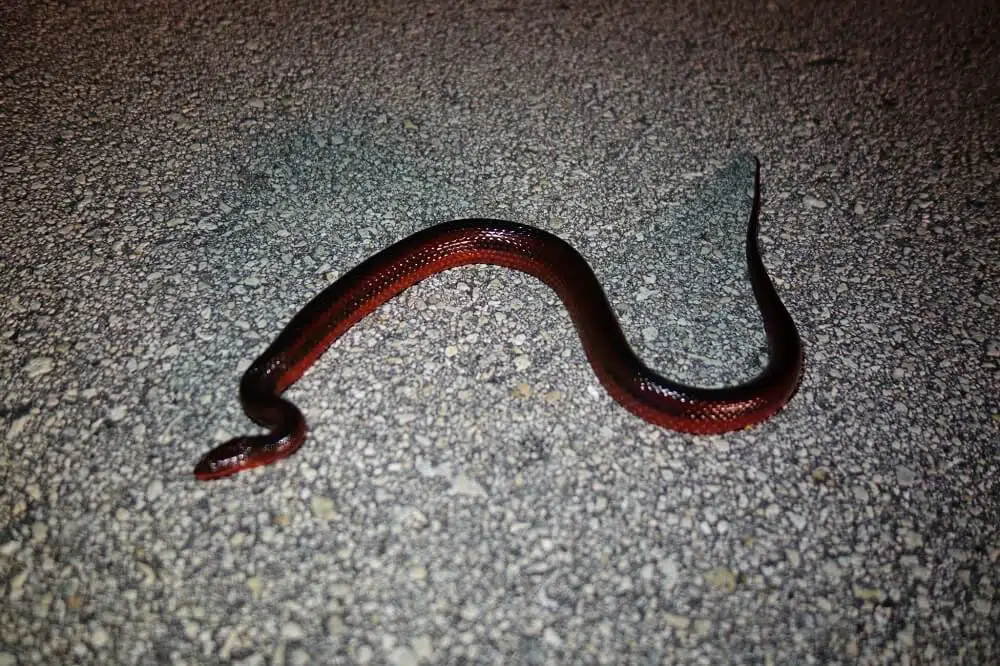
Scientific name: Liodytes alleni.
Common name: crayfish snake, Allen’s snake, striped swamp snake, striped swampsnake, swamp snake.
Venomous: No
The striped swamp snake or striped crayfish snake is a small semi-aquatic snake that grows to around 20 inches in total length, including the tail.
They have heavy bodies with yellow ventral sides and dark spots.
They can be found in wetlands, cypress swamps, prairies, swamps, and ditches on the side of the road.
Even though they are aquatic, they are commonly seen basking in the sun and not in the water.
They are common in southeastern Georgia.
They remain active throughout the year, except when it really gets cold.
They can be found along with the aquatic vegetation roots and on land between logs.
They eat mostly crayfish, coiling up to hold the prey while they eat it. They have sharp teeth which help them break the outer covering of the crayfish.
15. Florida Green Watersnake

Scientific name: Nerodia floridana.
Common name: Florida Green Watersnake, Eastern Green Watersnake.
Venomous: No
The Florida green water snake is a large water snake that can grow up to 140cm (55 inches).
They are a solid green to brown color with a white belly. Juveniles have dark bars down tier sides, which fade as they age.
They are endemic to the southeast and found in southern Georgia.
They prefer live vegetation and still waters, such as marshes and swamps. They can also be found in brackish water, lakes, ponds, and slow-moving rivers.
If you startle a Florida green water snake, it will slide in the water and swim away. However, if you corner or capture it, it will not hesitate to bite you and even though they are not venomous, their bites can be painful.
16. Black Swampsnake

Scientific name: Liodytes pygaea.
Common name: black swamp snake, black swampsnake, mud snake, red-bellied mud snake, and swamp snake.
Venomous: No
The black swamp snake is a small aquatic snake that only grows to 55cm.
They are highly aquatic and live in a range of open aquatic habitats including roadside ditches, sawgrass prairies, ponds, lakes, and bays.
They are very secretive and therefore seldom seen, as they hide and hunt in the water. They will seldom bite, even if restrained.
These snakes remain active within the water during the day and night, where they feed on tadpoles, small frogs, and fish.
Summary
All 16 water snakes in Georgia will rather move away if startled than to face you. Some will rarely be observed because they spend their lives under the water.
If you come across one of the venomous species of cottonmouths, leave them alone and do not try and corner or capture them, avoiding the risk of a serious bite.
Further Reading: